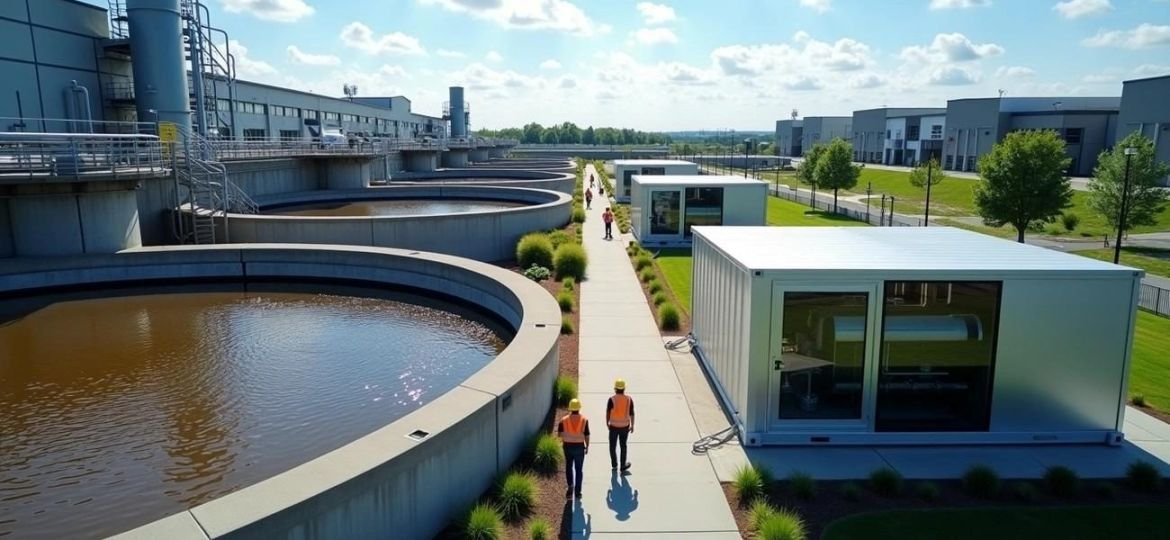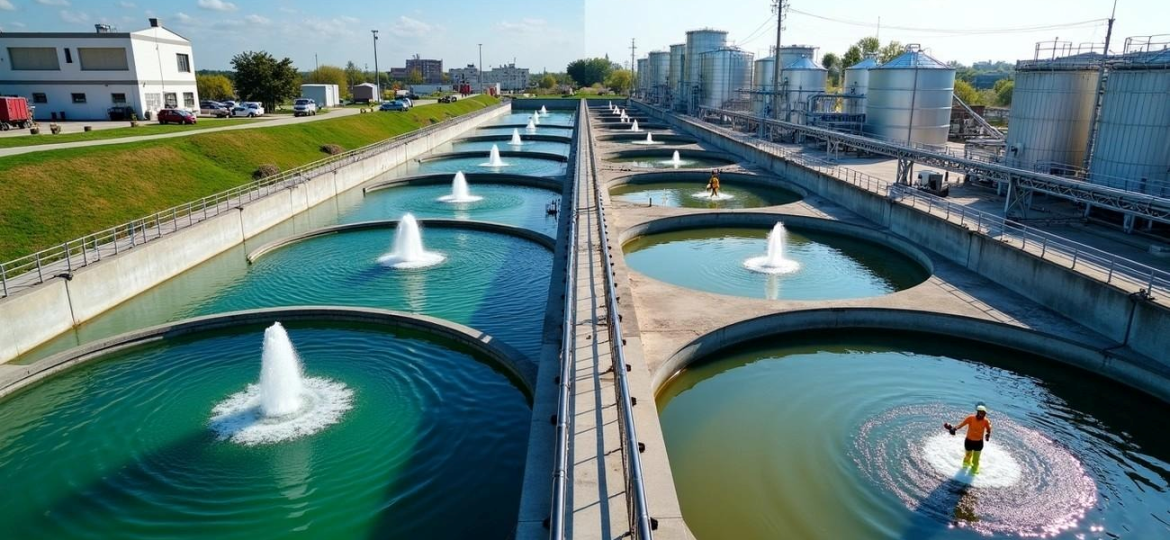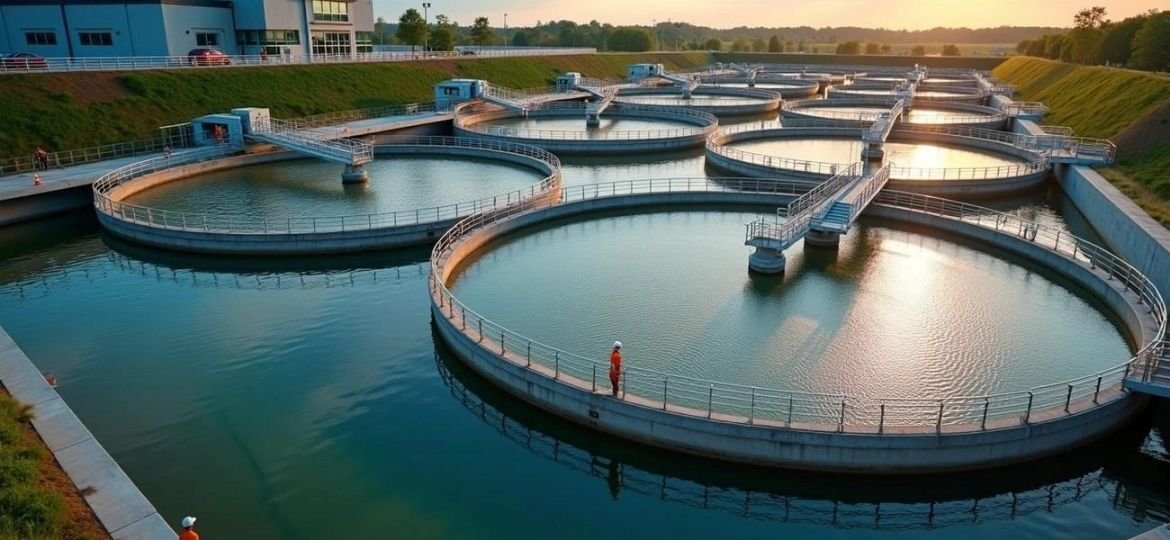In an era where sustainability and environmental protection are at the forefront of global priorities, Sewage Water Treatment Plants (STP Plants) play a vital role in managing water resources effectively. Every day, we use water for a wide range of activities—from drinking and bathing to cleaning and industrial processes. But have you ever wondered what happens to the water we discard? This wastewater doesn’t simply disappear; it undergoes complex treatment of sewage processes in sewage treatment plants to make it safe for reuse or discharge back into the environment. In this blog, we will delve into how the sewage treatment process functions, why it is essential, and the detailed steps involved in waste water treatment. Let’s explore how these wastewater treatment systems ensure that sewage is transformed into clean, safe water, meeting stringent water quality standards.
The Importance of Sewage Water Treatment Plants (STP Plants)
A sewage treatment plant, often abbreviated as an STP Plant or wastewater treatment plant (WWTP), is a critical facility designed to process and treat wastewater that comes from residential, commercial, and industrial sources. This includes water from sanitary sewers and sometimes combined sewers that also handle storm water. Without proper sewage treatment, this wastewater can pose significant risks to both human health and the environment. Understanding sewage characteristics and types of sewage, including domestic wastewater, industrial wastewater, and municipal wastewater, is crucial for effective treatment. Contaminants, bacteria, chemicals, and organic waste present in untreated sewage can pollute surface water and other water bodies, leading to ecosystem degradation and the spread of diseases.
The primary function of a sewage treatment works is to remove harmful contaminants from wastewater and return it to a safe condition, whether for water reuse or for safe release into natural water bodies like rivers, lakes, and oceans. The sewage treatment process ensures that untreated sewage doesn’t pollute receiving waters, protecting aquatic life, preserving natural ecosystems, and maintaining public health. This is particularly crucial in developing countries where water infrastructure may be less advanced.
How Does a Sewage Water Treatment Plant (STP Plant) Work?

A Sewage Water Treatment Plant (STP Plant) operates by passing wastewater through multiple treatment stages. These stages work in sequence to progressively clean the water and remove pollutants, ensuring that by the time the water leaves the facility, it meets or exceeds water quality standards. The entire process involves various sewage treatment systems and technologies designed to handle different aspects of waste water treatment.
Preliminary Treatment: The First Line of Defense
The first step in the sewage treatment process is preliminary treatment, where large debris, solids, and grit are removed from the sewage. As wastewater enters the sewage treatment plant, it passes through bar screens that trap large objects such as plastics, rags, and other solid waste. This stage prevents damage to the plant’s equipment and prepares the wastewater for further treatment.
Additionally, in this phase of primary wastewater treatment, the sewage may be sent through grit chambers where sand, grit, and other heavy materials are removed through a grit removal process. Pump stations are often used to move the sewage through these initial stages. This initial filtration is crucial as it ensures that the remaining treatment stages operate smoothly without obstructions. Some plants also incorporate flow equalization basins to manage varying inflow rates from sanitary sewers and combined sewers.
Primary Treatment: Separating Solids from Liquids
After the preliminary stage, the wastewater enters primary sedimentation, which focuses on separating suspended solids from liquids. The wastewater is allowed to sit in large settling tanks, where gravity forces solid particles to settle at the bottom of the tank. This settled material, known as sludge, is removed and processed separately, while the liquid wastewater moves to the next treatment stage.
The sludge that accumulates in the sedimentation tanks during primary treatment can be further treated through sludge treatment processes. In some cases, it can be repurposed as fertilizer. However, heavily contaminated sludge often requires additional treatment, such as de-watering or incineration, to stabilize it and ensure it poses no risk to the environment. The sludge retention time is carefully managed to optimize the treatment process.
Secondary Treatment: Biological Breakdown of Waste
Secondary wastewater treatment is the biological treatment phase, where microorganisms play a key role in breaking down organic matter and contaminants. This phase relies on naturally occurring bacteria and other microorganisms to digest harmful pathogens and pollutants in the wastewater. The process also helps reduce the biological oxygen demand of the water and removes ammonia nitrogen through the nitrification process.
There are two common methods used during secondary treatment:
- Activated Sludge Process: In this method, wastewater is mixed with oxygen in aeration tanks to stimulate the growth of bacteria that consume organic pollutants. The process often includes return activated sludge to maintain the bacterial population. The hydraulic retention time is carefully controlled to ensure optimal treatment efficiency.
- Trickling Filter System: In this process, wastewater trickles over a bed of aggregate material (like gravel), where microorganisms attached to the surface of the aggregate break down the contaminants.
Other aerobic treatment methods may include rotating biological contactors or sequencing batch reactors. A rotating biological contactor consists of a series of circular discs mounted on a rotating shaft, which alternately dip into the wastewater and expose the attached microorganisms to air. Sequencing batch reactors combine all treatment steps in a single tank, operating in a fill-and-draw sequence. After secondary treatment, the water passes through secondary clarifiers to separate the treated water from the biological solids.
Tertiary Treatment: Advanced Water Purification
The final stage of sewage treatment is tertiary treatment, which is designed to bring the water to a level of purity suitable for specific uses, such as irrigation, industrial reuse, or even direct release into sensitive environments like shellfish waters or recreational areas.
Tertiary treatment may involve several advanced processes, including:
- Microfiltration: Water is forced through tiny holes to remove remaining particles.
- Ion Exchange: Unwanted ions in the water are replaced with less harmful ions.
- Activated Carbon Adsorption: Organic chemicals and contaminants are absorbed by activated carbon filters.
- UV Disinfection: UV light is used to kill any remaining pathogens or bacteria.
- Biological Nutrient Removal: This process targets the removal of nitrogen and phosphorus from the wastewater, including total phosphorus and total nitrogen. Phosphorus removal and nitrogen removal are crucial steps in preventing eutrophication in receiving water bodies.
- Reverse Osmosis: A high-pressure filtration method that removes even the smallest contaminants.
- Ultrafiltration: A membrane filtration process that removes suspended solids and macromolecules.
- Advanced Oxidation: A process that uses oxidizing agents to remove organic and inorganic materials.
Once the water has undergone tertiary wastewater treatment, it is typically clean enough to be safely returned to the environment or repurposed for non-potable uses, such as landscaping or industrial cooling. In some cases, it may even be treated to potable reuse standards.
Benefits of a Sewage Water Treatment Plant (STP Plant)

The benefits of having a well-functioning Sewage Water Treatment Plant (STP Plant) extend far beyond simply cleaning wastewater. These facilities offer significant advantages to both the environment and human health:
- Prevents Pollution: By treating sewage before it enters natural water bodies, STP Plants help prevent water pollution and protect aquatic ecosystems from harmful contaminants, reducing the environmental impact of human activities.
- Supports Public Health: Properly treated wastewater reduces the risk of waterborne diseases and ensures that our water supply remains safe and clean.
- Promotes Water Recycling: In water-scarce regions, treated wastewater can be reused for irrigation, industrial processes, and even potable purposes after advanced treatment. This water reuse process helps conserve valuable freshwater resources.
- Conserves Natural Resources: By recycling and reusing water, Sewage Water Treatment Plants help conserve valuable freshwater resources and produce reclaimed water for various applications.
- Resource Recovery: Modern treatment plants often incorporate resource recovery and energy recovery systems, turning waste into valuable resources like biogas or fertilizers.
- Water Disposal: Proper treatment ensures safe water disposal into the environment, protecting ecosystems and complying with environmental regulations.
The Role of Automation in Modern Sewage Water Treatment Plants
With advances in technology, many modern sewage treatment plants are now highly automated. These systems are equipped with sensor technology, networks, and automatic controls that monitor every stage of the treatment process. Automation enhances plant efficiency, reduces the likelihood of human error, and ensures that treated water consistently meets safety standards.
This reliance on automation has made it easier for plants to operate around the clock, improving overall performance and reliability. Advanced STP technology incorporates processes like anaerobic digestion, chemical precipitation, and membrane bioreactor systems to enhance treatment efficiency. Some plants are even working towards becoming energy neutral by harnessing the energy potential in wastewater.
Alternative Approaches to Wastewater Treatment
While centralized sewage treatment plants are common in urban areas, there are alternative approaches to wastewater management that can be effective in different contexts:
- Decentralized Systems: These smaller-scale treatment facilities can be effective for rural or suburban areas, reducing the need for extensive sewer networks.
- On-site Treatment: Systems like septic systems provide localized treatment for individual properties or small communities.
- Natural Treatment Systems: Methods such as constructed wetlands and waste stabilization ponds use natural processes to treat wastewater, often with lower energy requirements.
- Industrial Effluent Treatment: Specialized systems designed to handle industrial effluent with unique contaminants not typically found in domestic wastewater.
These alternative approaches can complement traditional sewage treatment plants, especially in areas where centralized infrastructure is not feasible or cost-effective.
Conclusion: The Future of Water Management Lies in Sewage Treatment Plants
As global water resources continue to face challenges from climate change, urbanization, and pollution, the role of sewage treatment plants is more critical than ever. These plants not only help safeguard public health and the environment but also contribute to sustainable water management by recycling and purifying wastewater for reuse. Adopting an efficient wastewater treatment model ensures that STP plants operate at optimal capacity, providing effective solutions for wastewater management while promoting sustainability and resource conservation.
Understanding how a sewage treatment plant functions and the importance of its various stages—from preliminary filtration to tertiary treatment—gives us insight into the essential work that goes into keeping our water clean and safe. In the context of residential water treatment, these processes ensure that wastewater from households is effectively treated before being safely released into the environment or reused for non-potable purposes. Each stage plays a crucial role in removing contaminants, improving water quality, and contributing to sustainable water management.
Whether for industrial reuse, agricultural irrigation, or simply ensuring the safety of our water bodies, sewage treatment plants will continue to play a pivotal role in securing a sustainable future for our planet. As we move towards a circular economy and strive to meet sustainable development goals, particularly SDG 6 which focuses on clean water and sanitation, the importance of efficient and innovative sewage treatment processes cannot be overstated.
Frequently Asked Questions
1. What is a Sewage Treatment Plant (STP) and why is it important?
A sewage treatment plant (STP) is a system that treats wastewater from residential, commercial, and industrial sources to remove contaminants before releasing it back into the environment. It helps prevent water pollution, protects public health, and supports water reuse.
2. How does a sewage treatment plant work?
An STP works in stages—preliminary treatment (screening), primary treatment (sedimentation), secondary treatment (biological process), and tertiary treatment (disinfection). Each stage progressively removes solids, organic matter, and harmful microorganisms to produce treated water.
3. What are the main components of a sewage treatment plant?
Key components include screens and grit chambers, primary clarifier, aeration tanks, secondary clarifier, sludge treatment units, and disinfection systems. Some modern plants also use advanced filtration and automation for better efficiency.
4. What is the difference between primary, secondary, and tertiary treatment in an STP?
Primary Treatment: Removes suspended solids through sedimentation.
Secondary Treatment: Uses biological processes (aerobic/anaerobic bacteria) to break down organic matter.
Tertiary Treatment: Advanced filtration and disinfection to meet regulatory standards and enable reuse.
5. Can treated sewage water be reused?
Yes, treated sewage water can be reused for gardening, irrigation, industrial cooling, toilet flushing, and groundwater recharge. Advanced STPs ensure water meets safety standards for non-potable applications, promoting sustainability.







4 Comments
[…] 0 By Akshat Tyagi Latest Blogs September 30, […]
Mahabal Enviro Engineers Pvt. Ltd. provides environmental consultancy, testing and analytical services, calibration services, legal consultancy etc.For more details visit https://mahabal.com/
[…] is designed to simplify installation and maintenance, making it an ideal choice for modern sewage water treatment plants. Below, we outline the key features that make the SUSBIO ECOTREAT stand […]
[…] in wastewater management, exploring the transformative benefits of integrating effective sewage treatment plants (STPs). From regulatory pressures to operational complexities, we uncover why investing in […]